Dear Zazie, Here is today’s Lovers’ Chronicle from Mac Tag dedicated to his muse. Follow us on twitter @cowboycoleridge. Is there someone you cannot get over? Does it make no difference? Is it true that there is no love as true as the love that dies untold? Rhett
The Lovers’ Chronicle
Dear Muse,
a flame rekindled
though buried so long
here bein’ told
the only sighs
that linger
thereon,
those of, yes
and wide wonder
put your ear
close to my lips
i will whisper
what you need to hear
an age old tale
now unfoldin’, of two
who could only be saved
by findin’ each other
© copyright 2022 mac tag/cowboy coleridge all rights reserved
© copyright 2020 mac tag/cowboy coleridge all rights reserved
© copyright 2019 mac tag/cowboy coleridge all rights reserved
The soundtrack that should be playin’ in your head as you read this; Bird’s saxophone, and Dinah W.’s voice…
does the flame burn on
though buried so long
is it there
is it true
if it goes untold
a sigh lingers
thereon
in the wonderin’
put your ear
close to my lips
i will whisper
what you need to hear
you say comfort lies there
but i cannot save you
we can only save
each other
© copyright 2018 mac tag/cowboy coleridge all rights reserved
i see you as you looked
that August evenin’,
with the wind in your hair,
in the swiftly fadin’ last light
a crescent moon begins
its sojourn across the sky
the ripplin’ waters
of the creek’s current
the horses graze
on the prairie grass
the sparkle, far & wide
in the darkenin’ sky
the lightnin’ flash
on the horizon
all this unnoticed
while i gazed thereon
because you were near
© copyright 2017 mac tag/cowboy Coleridge all rights reserved
Love That Dies Untold
Love is the key
That opens the gate
Of happiness
Love lost is the key
That opens the gate
Of fear and longin’
The flame still burns
The shadow will not fade
There is no sigh
Like the lover’s sigh
So put your ear
Close to my lips
As I whisper
The lover’s secret
There is no love
As true as the love
That dies untold
© copyright 2012 mac Tag/Cowboy Coleridge all rights reserved
It indeed makes no difference. The flame still burns and the shadow never fades and there is no love as true as the love that dies untold. I cannot get over you.
| Jean-Auguste-Dominique Ingres | |
|---|---|
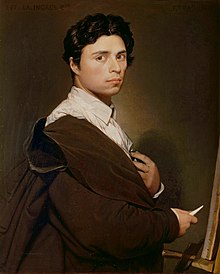
Self-portrait at age 24, 1804 (revised c. 1850), oil on canvas, 78 x 61 cm, Musée Condé
|
|
Today is the birthday of Jean-Auguste-Dominique Ingres (Montauban, Languedoc; 29 August 1780 – 14 January 1867 Paris); Neoclassical painter. Although he considered himself to be a painter of history in the tradition of Nicolas Poussin and Jacques-Louis David, by the end of his life it was Ingres’s portraits, both painted and drawn, that were recognized as his greatest legacy. He assumed the role of a guardian of academic orthodoxy against the ascendant Romantic style represented by Eugène Delacroix. His expressive distortions of form and space make him an important precursor of modern art.
In the summer of 1806 Ingres became engaged to Marie-Anne-Julie Forestier, a painter and musician, before leaving for Rome in September. His refusal to return to Paris led to the breaking up of his engagement. Julie Forestier, when asked years later why she had never married, responded, “When one has had the honor of being engaged to M. Ingres, one does not marry.”
In 1813 Ingres married a young woman, Madeleine Chapelle, who had been recommended to him by her friends in Rome. After a courtship carried out through correspondence, he proposed to her without having met her, and she accepted. Their marriage was a happy one, and Madame Ingres acquired a faith in her husband which enabled her to combat with courage and patience the difficulties of their common existence.
Ingres’ wife died on 27 July 1849. The following year Ingres, at seventy-one years of age, married forty-three-year-old Delphine Ramel, a relative of his friend Marcotte d’Argenteuil. This marriage proved as happy as his first.
Ingres died of pneumonia on 14 January 1867, at the age of eighty-six, having preserved his faculties to the last. He is interred in the Père Lachaise Cemetery in Paris with a tomb sculpted by his student Jean-Marie Bonnassieux. The contents of his studio, including a number of major paintings, over 4000 drawings, and his violin, were bequeathed by the artist to the city museum of Montauban, now known as the Musée Ingres.
Gallery



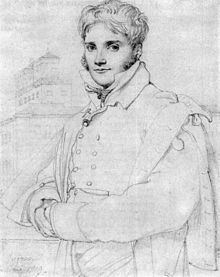
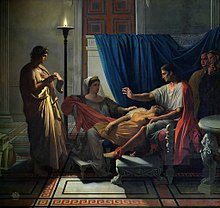

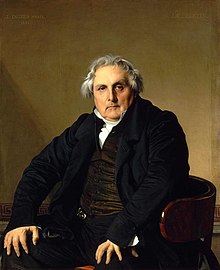




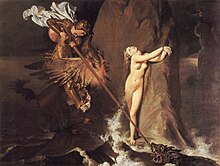

-

Academic Study of a Male Torso, 1801, National Museum in Warsaw
-

The Valpinçon Bather, 1808, Louvre
-
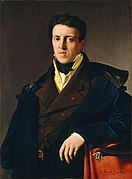
Marcotte d’Argenteuil, 1810, National Gallery of Art
-

Jupiter and Thetis, 1811, Musée Granet in Aix-en-Provence
-

Portrait of Niccolò Paganini, 1819
-
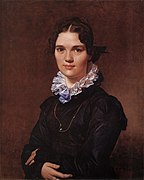
Mademoiselle Jeanne-Suzanne-Catherine Gonin, 1821, Taft Museum of Art
-

Baronne de Rothschild, 1848, Rothschild Collection, Paris
-

Louise de Broglie, Countess d’Haussonville, 1845, Frick Collection
-
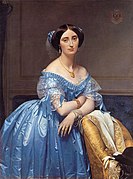
Princesse Albert de Broglie, née Joséphine-Eléonore-Marie-Pauline de Galard de Brassac de Béarn, 1853, Metropolitan Museum of Art
-

Joan of Arc at the Coronation of Charles VII, 1854, Louvre
-

The Source, 1856, Musée d’Orsay
-

Mme. Moitessier, 1856, National Gallery
**************************************
Today is the birthday of Oliver Wendell Holmes (Cambridge, Mass.; August 29, 1809 – October 7, 1894 Boston); physician, poet, professor, lecturer, polymath, and author. Grouped among the fireside poets, he was acclaimed by his peers as one of the best writers of the day. His most famous prose works are the “Breakfast-Table” series, which began with The Autocrat of the Breakfast-Table (1858). He was also an important medical reformer. In addition to his work as an author and poet, Holmes also served as a physician, professor, lecturer, inventor, and, although he never practiced it, he received formal training in law.
On June 15, 1840, Holmes married Amelia Lee Jackson at King’s Chapel in Boston. She was the daughter of the Hon. Charles Jackson, formerly Associate Justice of the Massachusetts Supreme Judicial Court, and the niece of James Jackson, the physician with whom Holmes had studied. Judge Jackson gave the couple a house at 8 Montgomery Place, which would be their home for eighteen years. They had three children: Civil War officer and American jurist Oliver Wendell Holmes Jr. (1841–1935), Amelia Jackson Holmes (1843–1889), and Edward Jackson Holmes (1846–1884).
Here is the Poem of the Day.
The Lover’s Secret
WHAT ailed young Lucius? Art had vainly tried
To guess his ill, and found herself defied.
The Augur plied his legendary skill;
Useless; the fair young Roman languished still.
His chariot took him every cloudless day
Along the Pincian Hill or Appian Way;
They rubbed his wasted limbs with sulphurous oil,
Oozed from the far-off Orient’s heated soil;
They led him tottering down the steamy path
Where bubbling fountains filled the thermal bath;
Borne in his litter to Egeria’s cave,
They washed him, shivering, in her icy wave.
They sought all curious herbs and costly stones,
They scraped the moss that grew on dead men’s bones,
They tried all cures the votive tablets taught,
Scoured every place whence healing drugs were brought,
O’er Thracian hills his breathless couriers ran,
His slaves waylaid the Syrian caravan.
At last a servant heard a stranger speak
A new chirurgeon’s name; a clever Greek,
Skilled in his art; from Pergamus he came
To Rome but lately; GALEN was the name.
The Greek was called: a man with piercing eyes,
Who must be cunning, and who might be wise.
He spoke but little,–if they pleased, he said,
He ‘d wait awhile beside the sufferer’s bed.
So by his side he sat, serene and calm,
His very accents soft as healing balm;
Not curious seemed, but every movement spied,
His sharp eyes searching where they seemed to glide;
Asked a few questions,–what he felt, and where?
‘A pain just here,’ ‘A constant beating there.’
Who ordered bathing for his aches and ails?
‘Charmis, the water-doctor from Marseilles.’
What was the last prescription in his case?
‘A draught of wine with powdered chrysoprase.’
Had he no secret grief he nursed alone?
A pause; a little tremor; answer,–‘None.’
Thoughtful, a moment, sat the cunning leech,
And muttered ‘Eros!’ in his native speech.
In the broad atrium various friends await
The last new utterance from the lips of fate;
Men, matrons, maids, they talk the question o’er,
And, restless, pace the tessellated floor.
Not unobserved the youth so long had pined
By gentle-hearted dames and damsels kind;
One with the rest, a rich Patrician’s pride,
The lady Hermia, called ‘the golden-eyed’;
The same the old Proconsul fain must woo,
Whom, one dark night, a masked sicarius slew;
The same black Crassus over roughly pressed
To hear his suit,–the Tiber knows the rest.
(Crassus was missed next morning by his set;
Next week the fishers found him in their net.)
She with the others paced the ample hall,
Fairest, alas! and saddest of them all.At length the Greek declared, with puzzled face,
Some strange enchantment mingled in the case,
And naught would serve to act as counter-charm
Save a warm bracelet from a maiden’s arm.
Not every maiden’s,–many might be tried;
Which not in vain, experience must decide.
Were there no damsels willing to attend
And do such service for a suffering friend?
The message passed among the waiting crowd,
First in a whisper, then proclaimed aloud.
Some wore no jewels; some were disinclined,
For reasons better guessed at than defined;
Though all were saints,–at least professed to be,–
The list all counted, there were named but three.
The leech, still seated by the patient’s side,
Held his thin wrist, and watched him, eagle-eyed.
Aurelia first, a fair-haired Tuscan girl,
Slipped off her golden asp, with eyes of pearl.
His solemn head the grave physician shook;
The waxen features thanked her with a look.
Olympia next, a creature half divine,
Sprung from the blood of old Evander’s line,
Held her white arm, that wore a twisted chain
Clasped with an opal-sheeny cymophane.
In vain, O daughter I said the baffled Greek.
The patient sighed the thanks he could not speak.Last, Hermia entered; look, that sudden start!
The pallium heaves above his leaping heart;
The beating pulse, the cheek’s rekindled flame,
Those quivering lips, the secret all proclaim.
The deep disease long throbbing in the breast,
The dread enchantment, all at once confessed!
The case was plain; the treatment was begun;
And Love soon cured the mischief he had done.Young Love, too oft thy treacherous bandage slips
Down from the eyes it blinded to the lips!
Ask not the Gods, O youth, for clearer sight,
But the bold heart to plead thy cause aright.
And thou, fair maiden, when thy lovers sigh,
Suspect thy flattering ear, but trust thine eye;
And learn this secret from the tale of old
No love so true as love that dies untold .. . . . . . . . . .
‘Bravo, Annex!’ they shouted, every one,–
‘Not Mrs. Kemble’s self had better done.’
‘Quite so,’ she stammered in her awkward way,–
Not just the thing, but something she must say.The teaspoon chorus tinkled to its close
When from his chair the MAN OF LAW arose,
Called by her voice whose mandate all obeyed,
And took the open volume she displayed.
Tall, stately, strong, his form begins to own
Some slight exuberance in its central zone,–
That comely fulness of the growing girth
Which fifty summers lend the sons of earth.
A smooth, round disk about whose margin stray,
Above the temples, glistening threads of gray;
Strong, deep-cut grooves by toilsome decades wrought
On brow and mouth, the battle-fields of thought;
A voice that lingers in the listener’s ear,
Grave, calm, far-reaching, every accent clear,–
(Those tones resistless many a foreman knew
That shaped their verdict ere the twelve withdrew
A statesman’s forehead, athlete’s throat and jaw,
Such the proud semblance of the Man of Law.
His eye just lighted on the printed leaf,
Held as a practised pleader holds his brief.
One whispered softly from behind his cup,
‘He does not read,–his book is wrong side up!
He knows the story that it holds by heart,–
So like his own! How well he’ll act his part!’
Then all were silent; not a rustling fan
Stirred the deep stillness as the voice beganThe line from above, no love so true as love that dies untold, inspired the Song of the Day – My Morning Jacket‘s version of “It Makes No Difference.”
| Ingrid Bergman
|
|---|
And today is the birthday of Ingrid Bergman and also the day she died (Stockholm; 29 August 1915 – 29 August 1982 London); actress who starred in a variety of European and American films. She won three Academy Awards, two Emmy Awards, four Golden Globe Awards, a BAFTA Award, and the Tony Award for Best Actress. Perhaps best remembered for her roles as Ilsa Lund in Casablanca (1942) and as Alicia Huberman in Notorious (1946), an Alfred Hitchcock thriller starring Cary Grant and Claude Rains.
Before becoming a star in American films, Bergman had been a leading actress in Swedish films. Her introduction to American audiences came with her starring role in the English-language remake of Intermezzo (1939). At her insistence, producer David O. Selznick agreed not to sign her to a contract – for four films rather than the then-standard seven-year period, also at her insistence – until after Intermezzo had been released.
Selznick’s financial problems meant that Bergman was often loaned to other studios. Apart from Casablanca, her performances from this period include Victor Fleming’s remake of Dr. Jekyll and Mr. Hyde (1941), For Whom the Bell Tolls (1943), Gaslight (1944), and The Bells of St. Mary’s (1945). Her last films for Selznick were Alfred Hitchcock’s Spellbound (1945) and Notorious (1946). Her final film for Hitchcock was Under Capricorn (1949).
After a decade in American films, she starred in Roberto Rossellini’s Stromboli (1950), following the revelation that she was having an extramarital affair with the director. The affair and then marriage with Rossellini created a scandal in the US that forced her to remain in Europe for several years, when she made a successful Hollywood return in Anastasia (1956), for which she won her second Academy Award. Many of her personal and film documents can be seen in the Wesleyan University Cinema Archives.
In 1948, Bergman sent a letter to Italian director Roberto Rossellini, proposin’ a collaboration:
-
- Dear Mr. Rossellini,
- I saw your films Open City and Paisan, and enjoyed them very much. If you need a Swedish actress who speaks English very well, who has not forgotten her German, who is not very understandable in French, and who in Italian knows only “ti amo”, I am ready to come and make a film with you.
-
- Ingrid Bergman
-
With this letter began one of the best known love stories in film history, with Bergman and Rossellini both at the peak of their careers. She went on to star in Rossellini’s Italian film Stromboli (1950), which led to a love affair while they were both already married. The affair and then marriage with Rossellini created a scandal that forced her to remain in Europe until 1956. Alas, it apparently was not true love for them; they divorced in 1957 and they both remarried.
Woody Guthrie wrote the lyrics for a song called “Ingrid Bergman”. Here it is performed by Billy Bragg. Click here!
Mac Tag
Love is the master-key that opens the gates of happiness, of hatred, of jealousy, and, most easily of all, the gate of fear. How terrible is the one fact of beauty. – Oliver Wendell Holmes

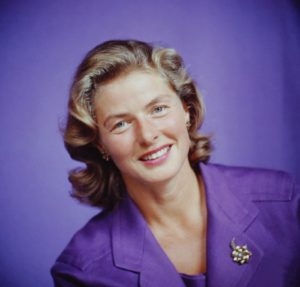
No Comments on "The Lovers’ Chronicle 29 August – thereon – art by Ingres – verse by Oliver Wendell Holmes – birth of Ingrid Bergman"